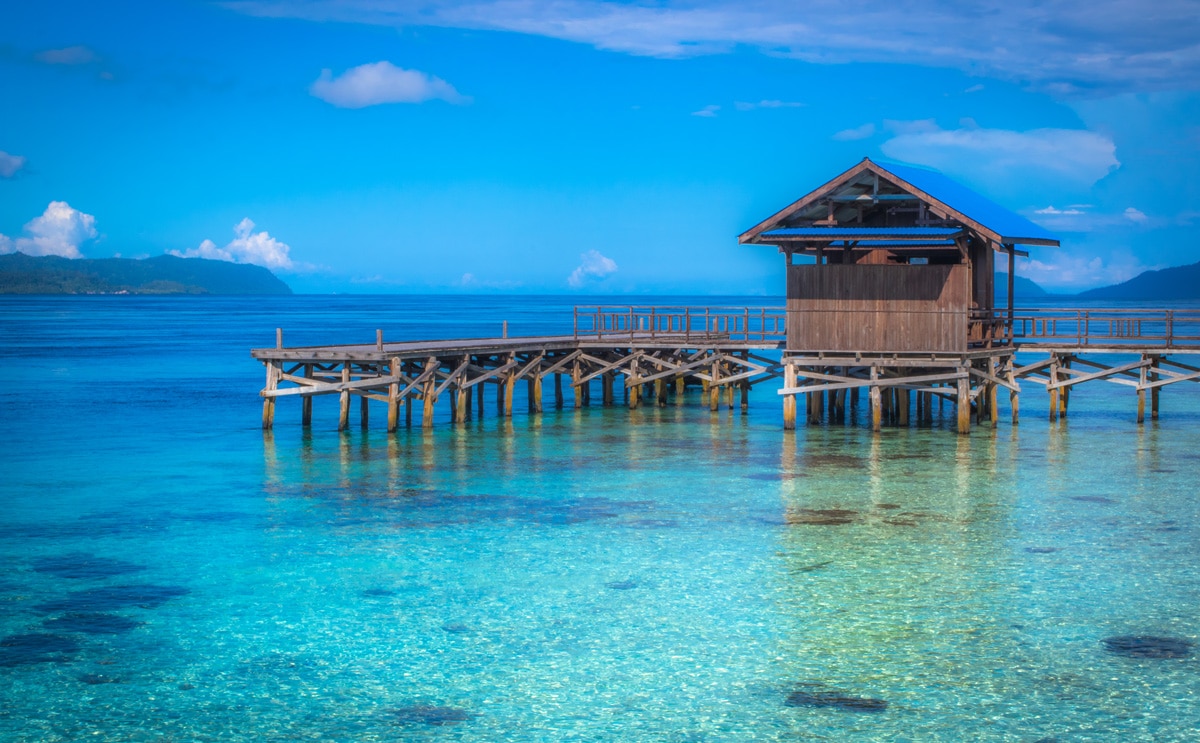The Indonesian Throughflow refers to the transfer of upper ocean waters from the Pacific to the Indian Ocean through the Indonesian Seas. This creates the pattern for all currents in Indonesia. A basic understanding of the Indonesian Throughflow and “Sverdrups” is essential if you want to know why the scuba diving can so be good in certain parts of the vast Indonesian Archipelago and less-so in other areas.
To the northwest of the Indonesian archipelago lies the Pacific Ocean where the sea level is 150 millimeters above average, whilst to the south lies the Indian Ocean where the sea level is 150 millimeters below average.
This 30-centimeter difference is caused by the trade winds and associated oceanic currents that run in opposite directions in the northern and southern hemispheres, the overall result is the largest movement of water on the planet which flows through the Indonesian archipelago from the Pacific Ocean to the north-east to the Indian Ocean in the south-west.
The volume of water associated with the Throughflow is so vast, that traditional measurements such as cubic meters and gallons are just not enough to describe it in an easily understandable way, therefore, the Norwegian scientist Harald Sverdrup came up with the “Sverdrup” which describes; “one million cubic meters of water per second.”
Inlay terms, think of a river that is 100 meters wide, 10 meters deep and flows at speeds of 4 knots, then imagine 500 of those rivers all combined together. That describes one Sverdrup.
It is estimated that the total amount of seawater that passes through the Indonesian Throughflow is between 20 to 22 Sverdrups, or 10,000 of those rivers. The throughflow is a massive volume of water which has to make its way around the chain of islands that runs along the bottom part of the Indonesian archipelago called the Lesser Sundas which stretch from Bali in the west to Timor in the east.
Of these, the 35 kilometers wide Lombok Strait offers the most direct path to the Indian Ocean and it is estimated that about 20% of the shallow water flow of the Indonesian Throughflow passes through that conduit, which in terms of rivers means 1500 of them. There are a limited number of channels between the islands of the Lesser Sundas and the main ones that carry the majority of the water flow are the Lombok Strait between Bali and Lombok, the Sape Strait between Sumbawa and Komodo and the Ombai Strait between Alor and Timor.
That is a vast amount of water, but what is so vital is that it carries with it the eggs and larvae of the marine life of the Indo-Pacific, which is an incredibly diverse area containing over 4000 identified species, compared to around 1000 in the Red Sea and 400 in the Caribbean.
This starts to explain the immense biodiversity of Bali’s beautiful reefs and dive sites. Another catalyst for this abundance also stems from the seasonal upwellings from the deep waters around the island of Bali.
As the Throughflow touches land in the north-east of the archipelago around Raja Ampat in Irian Jaya, Halmahera, and North Sulawesi it brings with it the eggs & larvae, along with the rich detritus of the sea that is swept up from the offshore deep basins by upwellings created by the huge volume of water flow.
Virtually everything that dies within this part of the ocean descends to the bottom where it decomposes and thus creates a rich layer of phosphorous and nitrogen-based nutrients which are sucked upwards by the upwellings.
When this natural process is taken into account, it starts to become clear why the areas around Raja Ampat in Irian Jaya, Halmahera and North Sulawesi are so rich in diverse marine.
A similar phenomenon occurs to the south, within the deep basins of the Banda Sea and the Lesser Sundar Islands, which also explains why this area is also so abundant.
The Indonesian archipelagos underwater topography is incredibly complex, with deep trenches, troughs, and basins surrounding its 18,000 islands. Around the Lesser Sundas, it is particularly complex, with the very deep Flores and Banda basins to the north and the Bali & Sunda trenches to the south. As the Indonesian Throughflow weaves its way over and through this detailed underwater landscape it creates upwellings that carry streams of nutrient-rich cold water from the deep, which nourish the reefs of eastern Bali and other hot spots on the island.
The Indonesian Throughflow varies seasonally in response to the monsoons and is also correlated with interannual variations in the Pacific, such as El Nino and the Southern Oscillation. Variations in the throughflow, therefore, affect the currents, and climate of both the Indian and Pacific Oceans.
Despite its origin in the Pacific, where surface temperatures are as warm as 29 degrees Celsius, the temperature in the Thru-Flow is a ‘cold’ 12 – 16 degrees. The Indian Ocean and the Pacific Ocean are the two largest pools of warm water within the global oceans The Indonesian Throughflow transfers warm, low salinity water from the Western Pacific to the Indian Ocean.
This also suggests that a lot of deeper, colder Pacific water is being exchanged via this throughflow. It also explains why diving at Nusa Penida, which is located at the center of a funnel between Bali and Lombok through which the throughflow travels at great speeds, is considered ‘cold water diving’.
The Indonesian Throughflow is strongest during the South-East monsoon (June, July, August) which means, that currents can reach up to 8 knots (1 knot = 1 nautical mile per hour = 1.852 km per hour)!
Water entering the internal Indonesian seas via the Makassar Strait and Lifamola Passage originates in both, the North-Pacific and the South Pacific Oceans. It then exits into the Indian Ocean via the Lombok Strait, the Sape Strait (that runs between Eastern Sumbawa and the island of Komodo), the Ombai Strait (which separates the islands of Kalabati and Timor at Alor), and the Timor Strait (that divides the island of Timor and North Australia). The Indonesian Throughflow consists primarily of North Pacific water flowing thru the Makassar Strait in the upper 500 meters, while water below is mostly of South Pacific origin. Whilst rushing through the Indonesian Archipelago, the Pacific Ocean waters are being mixed due to upwelling and interaction with surface waters before being transferred into the Indian Ocean.
When we look at the depth charts of the Lombok Strait, the enormous energies of this IndonesianThroughflow phenomenon are confirmed. Where the Indonesian Throughflow enters the strait, it is not only ‘squeezed’ by the funnel created by Bali’s eastern coast and Lombok’s South-Western isthmus, but at the same time, the bottom rises abruptly. While the depth averages 1500 meters as it enters the strait, it rises to around 400 meters at its center, just where the ‘squeeze’ between Bali and Lombok is the tightest and the 3 islands of Penida, Ceningan and Lembongan stand in its way, to immediately drop to 1500 meters again and into the Lombok Basin (3000 meters) just a few kilometers further south, and on to the Java Trench where the depth doubles once more (6000 meters) into the Indian Ocean.
It is hardly surprising then, that the currents around the Penida dive sites are often described as ‘ripping’, and that’s putting it mildly. Indeed, these areas dive sites are considered by many (together with Komodo and Raja Empat) as probably the most exciting dive sites in the world.
Not all Whale Sharks head in that direction, instead of some head east or west to perhaps enter the Indian Ocean via the Sunda Strait which separates Java and Sumatra, past the Island of Krakatoa. Alternatively, some even continue heading further north and end up in the South China Sea and the Philippines and perhaps even the North Pacific. migrating pattern of Whale Sharks is determined. The majority of the shark’s journey through the Indonesian archipelago riding the Throughflow to join the South Equatorial Current and eventually arrive in the Maldives, Madagascar, the East African Coast and the Cape of Good Hope.
Those heading east might enter the Indian Ocean via the Timor passage. It is impossible to say whether whale sharks decide to continue into the Indian Ocean or head West out of their own free will or whether they are ushered by an eddy created by prevailing weather patterns such as when a downwelling in the Indian Ocean reduces or even reverses the Indonesian Throughflow.
It would seem that, thanks to the phenomenon called The Indonesian Throughflow, not only do we have some of the most phenomenal dive sites in the world we also have an abundance of prevailing exceptional biodiversity amongst the marine life of this vast area.


